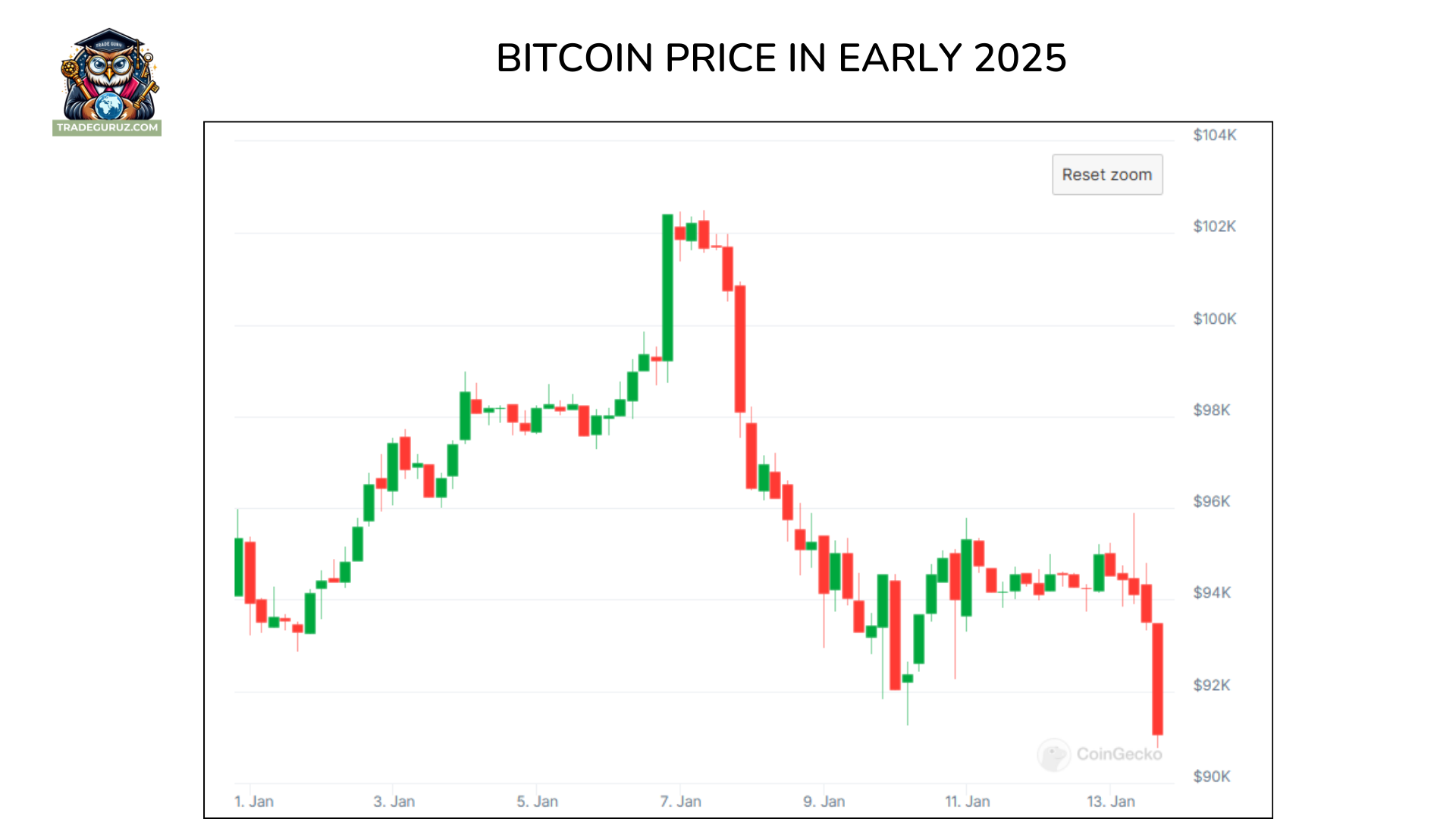



Crypto prices are renowned for being highly volatile, they can surge to new highs or plummet dramatically within hours. These fluctuations are not just random numbers but reflect the complex interaction of various factors, including the relationships between investors, countries, and cultural and social influences. Understanding the nature of it can help you navigate the market confidently and seize opportunities to maximize profits. Let’s dive into the blog post to explore the key factors influencing crypto prices.
Crypto prices are the value of a specific cryptocurrency at a given time, expressed in fiat currency. This price is not fixed but continuously fluctuates due to the influence of various factors. Such volatility creates significant opportunities for investors, but also presents risks, requiring sharp analytical skills and in-depth knowledge of the market. By closely tracking market fluctuations and grasping the reasons behind each change, you can effectively manage risks and uncover opportunities to optimize profits in this unpredictable market. Now we will explore the importance of cryptocurrency prices in trading activities.
The inherent volatility of digital asset prices gives investors opportunities to acquire assets at lower prices and sell them at higher values, thereby profiting from price differences. By monitoring these movements, investors can pinpoint optimal trading moments to ensure well-timed transactions.

The current price of a cryptocurrency often reflects the market's interest level and potential for future growth. Coins with stable long-term price growth are likely to have strong development potential. In comparison, coins with erratic price fluctuations often carry higher risks as they might be susceptible to market manipulation, speculative trends, and external factors. By analyzing these trends, investors can assess the growth potential of various coins, and then refine their investment strategies suitable for the market trends.
Understanding the fundamentals of cryptocurrency prices helps investors not only maximize profits but also limit avoidable errors. For example, if you recognize a significant price drop due to temporary market sentiment, you can avoid making impulsive decisions like panic selling. Similarly, when prices spike without a fundamental reason, investors can steer clear of the risks associated with buying at inflated levels.
Cryptocurrency prices are inherently volatile and highly unpredictable. With an in-depth knowledge of the factors influencing them; however, you can navigate market volatility more effectively and seize opportunities as they arise. What are the key factors driving these fluctuations? Let’s explore them in the sections below.
The law of supply and demand plays a key role in shaping the value of cryptocurrencies. When more people use crypto for transactions, investments, or value storage, the rising demand drives the price upward. Conversely, a drop in demand leads to a decrease in crypto prices. Additionally, the total supply of crypto is capped at 21 million coins, with a fixed number being mined each year. Halving events, which occur approximately every four years, reduce the number of new coins entering the market by 50%. These factors create supply scarcity and profoundly affect price movement. According to the law of supply and demand, a scarce asset is likely to have a higher value, whereas an asset with abundant supply tends to be priced lower.

Regulations and legal frameworks also have a significant influence on price formation. When a country or major institutions introduce supportive regulations or recognize cryptocurrencies, this boosts market confidence, often leading to increased demand and rising prices. For instance, in 2021, the U.S. Securities and Exchange Commission (SEC) approved the first Bitcoin Futures ETF. This development made it easier for investors to access the market, causing Bitcoin's price to surge from $40,000 to over $60,000 within a few months.
On the other hand, restrictive or prohibitive regulations often trigger panic and mass sell-offs, resulting in sharp price declines. A notable example occurred in 2021 when China imposed a comprehensive ban on cryptocurrency mining and trading. This move caused Bitcoin's price to drop significantly, from approximately $51,000 to $41,000 within one month.
Major global events such as economic crises, wars, or inflation can profoundly impact cryptocurrency prices. During periods of instability, people often turn to crypto as a safe-haven asset, increasing its value. A notable example is the 2022 Russia-Ukraine conflict. Initially, Bitcoin's price dropped due to widespread fear in global markets. However, as Ukraine used Bitcoin to receive international aid and Russians sought to move assets out of the country, the price surged from $35,000 to over $44,000 within weeks. This price shift further highlighted the growing importance of cryptocurrency as a dependable alternative asset, particularly in geopolitical instability.
Cryptocurrencies have become increasingly integrated into modern life, with most people first learning about them through news outlets, social media, or advertisements. Events, figures, or trends featured in the media can amplify public awareness, subsequently influencing Bitcoin's price volatility. For instance, Elon Musk's tweets publicly endorsing Bitcoin have frequently caused substantial market fluctuations. Similarly, financial analysis programs on channels like CNBC or Bloomberg significantly impact investor sentiment by providing insights, market forecasts, and in-depth reports. Viewers often rely on such information to guide their decisions, which can ultimately sway market trends and impact price movements.

The cryptocurrency market is highly volatile, predicting price can be a challenge. With technological advancements and innovative approaches; however, investors can simplify the forecasting process by leveraging the following trends:
Decentralized Finance (DeFi) combined with Artificial Intelligence (AI) delivers new methods for analyzing cryptocurrency prices. This trend leverages AI technology to simplify the complexities of DeFi, removing barriers for general users and enabling them to execute transactions without requiring an in-depth understanding of blockchain mechanisms. DeFAI serves as an intelligent assistant, helping investors analyze market data, predict trends, and provide personalized investment suggestions. By making the trading process more intuitive and accessible, DeFAI empowers users to make smarter, more confident decisions in the ever-changing crypto world.
Social Trading allows investors to learn from and replicate the strategies of experienced traders. This trend not only aids in price prediction but also reduces risks for newcomers. Social trading platforms like eToro or the Copy Trading feature on certain exchanges offer investor leaderboards, where users can review the trading performance of top traders and automatically copy their strategies. By utilizing this approach, beginners can benefit from the expertise of seasoned professionals, enabling them to make more precise investment decisions without requiring extensive market knowledge.
Machine Learning (ML) is increasingly employed to build predictive models for cryptocurrency prices. ML gathers and analyzes historical price data, trading volumes, market news, and even sentiments on social media to forecast future price trends. By harnessing its ability to process and learn from vast datasets, ML allows the creation of more precise models for forecasting price fluctuations. These insights empower investors with data-driven predictions, facilitating more informed and timely trading decisions in the highly volatile cryptocurrency market.
At the beginning of 2025, the cryptocurrency market experienced significant fluctuations, particularly with Bitcoin. The approval of a Bitcoin spot ETF in late 2024 prompted a large inflow of capital from major financial institutions, causing the Bitcoin price to stabilize around $97,000. On January 6, 2025, Bitcoin prices surpassed $100,000 for the first time in 2025, reaching $102,250 due to anticipation surrounding the inauguration of President-elect Donald Trump.
However, shortly after, investors' profit-taking and concerns over the Fed's high interest rate policies led to a 5% decline in Bitcoin’s price, bringing it down to $96,525 by January 8, 2025. These fluctuations reflected the natural dynamics of the market, as short-term investors seized the opportunity to realize profits, while macroeconomic factors continued to influence market sentiment.
Despite the decline, Bitcoin quickly stabilized around the $95,000 level due to support from large institutions such as BlackRock and Fidelity. These organizations have committed to long-term investments in the cryptocurrency market, demonstrating that Bitcoin remains strongly backed by institutional capital and confidence in its future potential.

Binance is a giant in the cryptocurrency market that stands out with competitive trading fees, starting at just 0.1% per Spot trade. Moreover, when traders use BNB to make a payment, they will be entitled to a 25% discount. With such low trading fees, Binance is both an ideal choice for high-volume traders and attracts newcomers thanks to its cost-efficient and flexible fee structure.
When discussing platforms with attractive fee structures, Bitget is a noteworthy option. Bitget applies a Maker-Taker fee structure with a Spot fee of only 0.1% for both Maker and Taker. For futures trading, the fee is 0.02% for Makers and 0.06% for Takers. In particular, users utilizing BGB tokens can receive a discount of up to 20%, making it an ideal choice for frequent traders seeking to optimize costs.
Kucoin is prominent in the industry with its low trading fees, starting from just 0.1%, and offers further reductions using KCS tokens. In addition, users participating in the VIP program can enjoy attractive fee discounts based on their trading volume or the amount of KCS held, helping to optimize costs effectively.
It is crucial to understand the movements of cryptocurrency prices in order to shape investment decisions. Gaining a deep insight into price impact factors such as supply and demand, regulatory policies, and geopolitical events allows investors to refine strategies and navigate trading more effectively. In addition, maintaining emotional control and staying composed before any variations is essential to protect your investment when trading in the crypto market.
Do not forget to thoroughly research and select reliable exchanges that align with your investment goals to maximize profit opportunities in the cryptocurrency market.
If you have any concerns, please contact us at TRADEGURUZ.